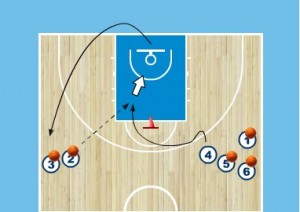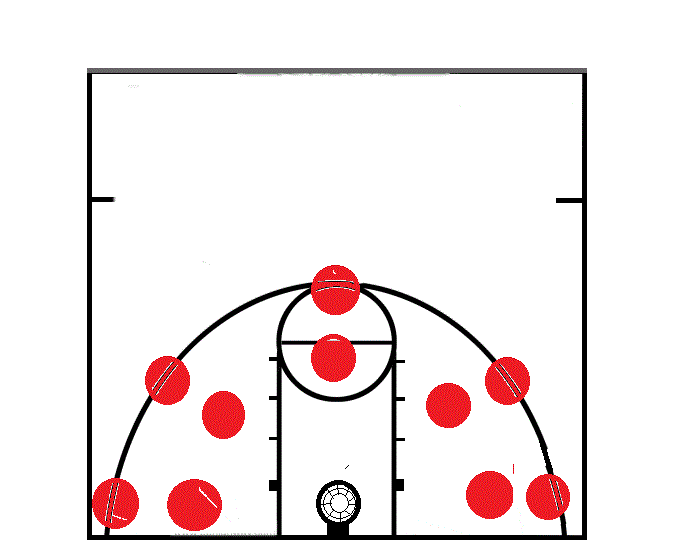Basketball drills
- One person shoots free throws.
- Two other players stand behind the one who throws the free throw.
- According to the rules of the game
- Once the ball is gone the three players go for the rebound.
- If the person who made the free throw has the ball, he can make another free throw.
- If he doesn't have the ball, the 2 other players go to the other side of the court to attack, 2 against 1.
- If attacker is pressured by defender then go to free man, otherwise keep going until lay-up.
- The next three players get ready to execute the exercise.
- 2 teams
- take turns shooting from all the blocks and dashes on the bucket edge
- and the free throw line together 5 hit
Try to hit as far as possible without error or loss of ball.
- Players stand in pairs (about the same size).
- On the whistle, the player with the ball dribbles to the opposite side while the player without the ball can do heavy defence.
- There may be physical pressure but no mistakes.
- Players stop when they have lost control of the ball or when the defence has taken it away.
- If the player with the ball touches the opposite side, he may dribble again in the next round but against a different defence.
- Half have a ball, the other half do not.
- Players are mixed up.
- At whistle: make eye contact and pass to someone without ball.
- Varying :
- Left hand and right hand dribble,
- vary passes
This drill can serve well as a warming up drill (passing / finishing) but is also a good breakdown for a "scissor" play, or "split the post". You can expand the drill to include other options that may or may not be used in your set play. You start off basic, simple, and as your team is ready, you expand the exercise further and further.

- The exercise starts with two rows on two spots (e.g. 2 guard spots).
- If you have a larger team, you work on 2 baskets. Again, we would like to see everyone finish as many balls as possible.
- So make the groups as small as possible, but at least 4-6 players per basket.
- #1 starts the exercise by making a preliminary move ("setting up" the defender) and cutting tightly over the pawn (or chair).
- As a trainer you can also stand here for a while as a high-post so that it becomes recognizable for the players.
- #4 passes the ball to the cutting in #1 and after his pass he immediately makes another pre-move and cuts across the pawn in the same way, then gets the ball from #2.
- Rotation: Each player catches his own ball, and joins the line from which he received the ball. The exercise continues in this manner continuously.
Variations:
- Vary speed. The players must first master the technique of cutting in. Set up a man, push off and accelerate, etc. (see teaching points). Then increase the pace.
- Receive and shoot the ball;
- Make a pop-out (when a defender passes underneath) and shoot;
- Train aggression with pad, unbalance players when cutting in;
- After cutting in, offer the ball at the low post and finish with a post move (also think of countermoves), use pads here too;
- Work with a high-post player (trainer or one of the players): Pass the ball to the high-post first and then: hand-off / hi-lo, etc (depending on your own options);
- Eventually work with defenders involved as well;
Teaching Points:
- Set up defenders;
- Push off on the outer foot and accelerate (change of direction = change of speed)
Aggressive cutting in!
- Cut straight over the pawn, do not make wide turns ("shoulder to shoulder");
- Communication in the passing game, seeking eye contact, clearly asking for the ball with the front hand, asking in front of the man and running into the ball;
- Finish from the left side with the left hand, and the same applies for the right side;
- Divide the players into 2 groups.
- Set up a track on both sides of the court where the players have to dribble in between.
- At the end of the course they can finish on goal.
Line up the children in two lines, encourage strong passes, whoever has 25 passes first sits on the ground.
We start with fake a pass, make a pass and pivot push pass, we do this without game form.
- Chest pass
- Bounce
- Push (left, right)
- Overhead
- three groups of two per basket
- try to make qualitatively equal pairs
- How?
- 1 pair in front, 2 in forward positions
- take turns making a drive, alternating attack/defence
- First of the pair to have 5 points, wins.
- Pairs run from baseline to baseline on the right side of the field,
- meanwhile chest pass back and forth,
- distance between them is approx. 3 metres.
- Return on the left side, but then with bounce-pass.
Line to line
- Right, left, skipping, handball, one-legged handball
- Stay behind the trainer, sprint
Attack
- Crossover with hesitation, fake crossover
- Between the legs
- Behind the back
- Combo, e.g. between the legs and behind the back
Defence
- Cap steps, sprint
- Slides
- Cap steps, slides at each line
Line up the children in two lines, encourage strong passes, whoever has 25 passes first sits on the ground.
We start with fake a pass, make a pass and pivot push pass, we do this without game form.
- Chest pass
- Bounce
- Push (left, right)
- Overhead
- The player gets the ball thrown to you
- Do a crossover and shoot the ball at the first position
- Do the same at the second position
- And so on









